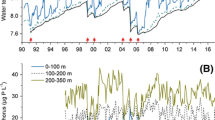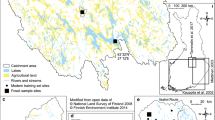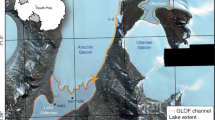Abstract
Heterotrophic respiration of organic matter (OM) is thought to dominate over aquatic primary production (PP) in most freshwater lake ecosystems. This paradigm implies that lateral transport of OM from the terrestrial biosphere subsidize the major fraction of aquatic respiration and that many lakes are a net source of carbon dioxide (CO2) to atmosphere. Nevertheless, African lakes were absent of the datasets upon which this paradigm was built. Here, we report a comprehensive and methodologically consistent data set of pelagic PP and community respiration (CR) obtained over the last decade in contrasting non-humic African lakes including 5 of the East African Great lakes (Tanganyika, Kivu, Edward, Albert, Victoria) and smaller shallow lakes located in Eastern Africa. Also, we determined the partial pressure of CO2 in surface waters and examined the sources and dynamics of organic and inorganic carbon by means of stable isotope tools across a wide range of physical and chemical conditions and productivity status. Our observations revealed that the threshold value at which the equivalence between PP and CR is met is substantially lower in Africa (10 mmol C m−3 d−1) than at higher latitude (25 mmol C m−3 d−1), suggesting that non-humic African lakes tend to be more autotrophic than expected from empirical relationships derived from data collected in boreal and temperate regions. Integrated at the regional scale, we estimate that PP is about 20 times higher than the organic carbon burial in sediments. It implies that a large fraction (< 90%) of PP is effectively recycled in the warm water column of non-humic African lakes.







Similar content being viewed by others
References
Alin SR, Johnson TC. 2007. Carbon cycling in large lakes of the world: A synthesis of production burial and lake-atmosphere exchange estimates. Global Biogeochemical Cycles. https://doi.org/10.1029/2006GB002881.
Badger MR, Price GD. 1994. The role of carbonic anhydrase in photosynthesis. Annual Review of Plant Biology 45(1):369–392.
Brothers S, Vadeboncoeur Y. 2021. Shoring up the foundations of production to respiration ratios in lakes. Limnology and Oceanography 66(7):2762–2778
Borges AV, Deirmendjian L, Bouillon S, Okello, W, Lambert T, Roland FA, Razanamahandry VF, Voarintsoa NRG, Darchambeau F, Kimirei IA, Descy J-P, Allen GH, Morana C. 2022. Greenhouse gas emissions from African lakes are no longer a blind spot. Science Advances 8(25):eabi8716.
Cole JJ. 1999. Aquatic microbiology for ecosystem scientists: new and recycled paradigms in ecological microbiology. Ecosystems 2(3):215–225.
Cole JJ, Caraco NF, Kling GW, Kratz TK. 1994. Carbon dioxide supersaturation in the surface waters of lakes. Science 265:1568–1570.
Cole JJ, Prairie YT, Caraco NF, McDowell WH, Tranvik LJ, Striegl RG, Melack J. 2007. Plumbing the global carbon cycle: integrating inland waters into the terrestrial carbon budget. Ecosystems 10(1):172–185.
Darchambeau F, Sarmento H, Descy JP. 2014. Primary production in a tropical large lake: The role of phytoplankton composition. Science of the Total Environment 473:178–188.
Deirmendjian L, Lambert T, Morana C, Bouillon S, Descy JP, Okello W, Borges AV. 2020. Dissolved organic matter composition and reactivity in Lake Victoria, the world’s largest tropical lake. Biogeochemistry 150(1):61–83.
Deirmendjian L, Descy J-P, Morana C, Okello W, Stoyneva-Gärtner MP, Bouillon S, Borges AV. 2021. Limnological changes in Lake Victoria since the mid-20th century. Freshwater Biology 66(8):1630–1647.
Del Giorgio PA, Peters RH. 1994. Patterns in planktonic P: R ratios in lakes: influence of lake trophy and dissolved organic carbon. Limnology and Oceanography 39(4):772–787.
Del Giorgio PA, Cole JJ, Cimbleris A. 1997. Respiration rates in bacteria exceed phytoplankton production in unproductive aquatic systems. Nature 385(6612):148–151.
Driessen, P., Deckers, J., Spaargaren, O., and Nachtergaele, F. (2000). Lecture notes on the major soils of the world Food and Agriculture Organization 94
Duarte CM, Agustí S. 1998. The CO2 balance of unproductive aquatic ecosystems. Science 281(5374):234–236.
Duarte CM, Prairie YT. 2005. Prevalence of heterotrophy and atmospheric CO 2 emissions from aquatic ecosystems. Ecosystems 8(7):862–870.
Fahnenstiel GL, Sayers MJ, Shuchman RA, Yousef F, Pothoven SA. 2016. Lake-wide phytoplankton production and abundance in the Upper Great Lakes: 2010–2013. Journal of Great Lakes Research 42(3):619–629.
Fee EJ. 1979. A relation between lake morphometry and primary production and its use in interpretating whole-lake experiments. Limnology and Oceanography 24:401–416.
Fick SE, Hijmans RJ. 2017. WorldClim 2: New 1km spatial resolution climate surfaces for global land areas. Int. J. Climatol. 37:4302–4315.
Fluet-Chouinard E, Lehner B, Rebelo L-M, Papa F, Hamilton SK. 2015. Development of a global inundation map at high spatial resolution from topographic downscaling of coarse-scale remote sensing data. Remote Sensing of Environment 158:348–361.
Geider RJ, Maclntyre HL, Kana TM. 1998. A dynamic regulatory model of phytoplanktonic acclimation to light, nutrients, and temperature. Limnology and Oceanography 43(4):679–694.
Gillikin DP, Bouillon S. 2007. Determination of delta O-18 of water and delta C-13 of dissolved inorganic carbon using a simple modification of an elemental analyzer-isotope ratio mass spectrometer: an evaluation. Rapid Communications in Mass Spectrometry 21(8):1475–1478.
Hama T, Miyazaki T, Ogawa Y, Iwakuma T, Takahashi M, Otsuki A, Ichimura S. 1983. Measurement of photosynthetic production of a marine phytoplankton population using a stable 13 C isotope. Marine Biology 73(1):31–36.
Isumbisho M, Sarmento H, Kaningini B, Micha JC, Descy JP. 2006. Zooplankton of Lake Kivu, East Africa, half a century after the Tanganyika sardine introduction. Journal of Plankton Research 28(11):971–989.
Kilham P, Kilham SS. 1990. Endless summer: internal loading processes dominate nutrient cycling in tropical lakes. Freshwater Biology 23(2):379–389.
Kirk JT. 1994. Light and photosynthesis in aquatic ecosystems. Cambridge University Press.
Kosten S, Huszar VL, Bécares E, Costa LS, van Donk E, Hansson LA, Scheffer M. 2012. Warmer climates boost cyanobacterial dominance in shallow lakes. Global Change Biology 18(1):118–126.
Kraemer BM, Chandra S, Dell AI, Dix M, Kuusisto E, Livingstone DM, McIntyre PB. 2017a. Global patterns in lake ecosystem responses to warming based on the temperature dependence of metabolism. Global Change Biology 23(5):1881–1890.
Kraemer BM, Mehner T, Adrian R. 2017b. Reconciling the opposing effects of warming on phytoplankton biomass in 188 large lakes. Scientific Reports 7(1):1–7.
Lehner B, Verdin K, Jarvis A. 2008. New global hydrography derived from spaceborne elevation data. Eos, Transactions American Geophysical Union 89(10):93–94.
Lewis WM Jr. 1996. Tropical lakes: how latitude makes a difference. Perspectives in Tropical Limnology 4364:43–64.
Lewis WM Jr. 2011. Global primary production of lakes: 19th Baldi Memorial Lecture. Inland Waters 1(1):1–28.
Lewis, E. R., and Wallace, D. W. R. (1998). Program developed for CO2 system calculations (No. cdiac: CDIAC-105). Environmental System Science Data Infrastructure for a Virtual Ecosystem
Marotta H, Duarte CM, Sobek S, Enrich-Prast A. 2009. Large CO2 disequilibria in tropical lakes. Global Biogeochemical Cycles. https://doi.org/10.1029/2008GB003434.
McDonald CP, Stets EG, Striegl RG, Butman D. 2013. Inorganic carbon loading as a primary driver of dissolved carbon dioxide concentrations in the lakes and reservoirs of the contiguous United States. Global Biogeochemical Cycles 27(2):285–295.
McIntyre PB, Michel E, Olsgard M. 2006. Top-down and bottom-up controls on periphyton biomass and productivity in Lake Tanganyika. Limnology and Oceanography 51(3):1514–1523.
Mendonça R, Müller RA, Clow D, Verpoorter C, Raymond P, Tranvik LJ, Sobek S. 2017. Organic carbon burial in global lakes and reservoirs. Nature Communications 8(1):1–7.
Messager ML, Lehner B, Grill G, Nedeva I, Schmitt O. 2016. Estimating the volume and age of water stored in global lakes using a geo-statistical approach. Nature Communications 7(1):1–11.
Millero FJ, Graham TB, Huang F, Bustos-Serrano H, Pierrot D. 2006. Dissociation constants of carbonic acid in seawater as a function of salinity and temperature. Marine Chemistry 100(1–2):80–94.
Mook WG, Bommerson JC, Staverman WH. 1974. Carbon isotope fractionation between dissolved bicarbonate and gaseous carbon dioxide. Earth and Planetary Science Letters 22(2):169–176.
Morales-Williams AM, Wanamaker AD Jr, Downing JA. 2017. Cyanobacterial carbon concentrating mechanisms facilitate sustained CO 2 depletion in eutrophic lakes. Biogeosciences 14(11):2865–2875.
Morán XAG, Estrada M, Gasol JM, Pedrós-Alió C. 2002. Dissolved primary production and the strength of phytoplankton–bacterioplankton coupling in contrasting marine regions. Microbial Ecology 44(3):217–223.
Morana C, Sarmento H, Descy JP, Gasol JM, Borges AV, Bouillon S, Darchambeau F. 2014. Production of dissolved organic matter by phytoplankton and its uptake by heterotrophic prokaryotes in large tropical lakes. Limnology and Oceanography 59(4):1364–1375.
Myklestad SM. 2000. Dissolved organic carbon from phytoplankton. Marine chemistry, . Springer: Berlin Heidelberg. pp 111–148.
Odum HT. 1956. Primary production in flowing waters 1. Limnology and Oceanography 1(2):102–117.
Pinho L, Duarte CM, Marotta H, Enrich-Prast A. 2016. Temperature dependence of the relationship between pCO 2 and dissolved organic carbon in lakes. Biogeosciences 13(3):865–871.
Prairie YT, Bird DF, Cole JJ. 2002. The summer metabolic balance in the epilimnion of southeastern Quebec lakes. Limnology and Oceanography 47:316–321.
Rawson DS. 1953. Morphometry as a dominant factor in the productivity of large lakes. Internationale Vereinigung Für Theoretische Und Angewandte Limnologie:verhandlungen 12(1):164–175.
Raymond PA, Hartmann J, Lauerwald R, Sobek S, McDonald C, Hoover M, Guth P. 2013. Global carbon dioxide emissions from inland waters. Nature 503(7476):355–359.
Reynolds CS. 2006. The ecology of phytoplankton. Cambridge, United Kingdom: Cambridge University Press.
Richey JE, Melack JM, Aufdenkampe AK, Ballester VM, Hess L. 2002. Outgassing from Amazonian rivers and wetlands as a large tropical source of atmospheric CO2. Nature 416:617–620.
Robarts RD, Zohary T. 1987. Temperature effects on photosynthetic capacity, respiration, and growth rates of bloom-forming cyanobacteria. New Zealand Journal of Marine and Freshwater Research 21(3):391–399.
Sanborn P, Lamontagne L, Hendershot W. 2011. Podzolic soils of Canada: Genesis, distribution, and classification. Canadian Journal of Soil Science 91(5):843–880.
Sarmento H, Descy JP. 2008. Use of marker pigments and functional groups for assessing the status of phytoplankton assemblages in lakes. Journal of Applied Phycology 20(6):1001–1011.
Sarmento H, Gasol JM. 2012. Use of phytoplankton-derived dissolved organic carbon by different types of bacterioplankton. Environmental Microbiology 14(9):2348–2360.
Sarmento H, Isumbisho M, Descy J-P. 2006. Phytoplankton ecology of Lake Kivu (East Africa). Journal of Plankton Research 28(9):815–829.
Sayers M, Bosse K, Fahnenstiel G, Shuchman R. 2020. Carbon Fixation Trends in Eleven of the World’s Largest Lakes: 2003–2018. Water 12(12):3500.
Staehr PA, Testa JM, Kemp WM, Cole JJ, Sand-Jensen K, Smith SV. 2012. The metabolism of aquatic ecosystems: history, applications, and future challenges. Aquatic Sciences 74(1):15–29.
Stenuite S, Pirlot S, Hardy MA, Sarmento H, Tarbe AL, Leporcq B, Descy JP. 2007. Phytoplankton production and growth rate in Lake Tanganyika: evidence of a decline in primary productivity in recent decades. Freshwater Biology 52(11):2226–2239.
Sterner RW, Keeler B, Polasky S, Poudel R, Rhude K, Rogers M. 2020. Ecosystem services of Earth’s largest freshwater lakes. Ecosystem Services 41:101046.
Vadeboncoeur Y, Devlin SP, McIntyre PB, Vander Zanden MJ. 2014. Is there light after depth? Distribution of periphyton chlorophyll and productivity in lake littoral zones. Freshwater Science 33(2):524–536.
Vollenweider RA. 1965. Calculations models of photosynthesis-depth curves and some implications regarding day rate estimates in primary production measurements. Memorie Dell’istituto Italiano Di Idrobiologia 18:425–457.
Yvon-Durocher G, Montoya JM, Trimmer M, Woodward GUY. 2011. Warming alters the size spectrum and shifts the distribution of biomass in freshwater ecosystems. Global Change Biology 17(4):1681–1694.
Acknowledgements
We are grateful to crews of RV Hammerkop and the Maman Benita for support during the sampling expeditions in Lakes Victoria and Tanganyika, to the team from the Institut Supérieur Pédagogique Bukavu for help during the sampling in Lake Kivu, to the Katwe marine police officers, Angela Nankabirwa and Erina Nabafu for help during sampling in Lakes Edward and George and Western Uganda lakes, to Marc-Vincent Commarieu, Bruno Leporcq, Zita Kelemen and Yannick Stroobandt for analytical support. This work was funded by the Belgian Federal Science Policy Office (BELSPO, HIPE project, BR/154/A1/HIPE, and EAGLES project, SD/AR/02A), by the Fonds National de la Recherche Scientifique (FNRS, LAVIGAS project, contract T.0156.18, and TANGAGAS project) and by the Spanish Ministry of Science and Technology (AGLOM project CGL2010-11556-E). Field expeditions were supported by FNRS with travel grants awarded to AVB, by the Fonds Agathon de Potter with travel grants awarded to CM and LD, by the Fonds Leopold III with a travel grant awarded to LD and by the Fonds Wetenschappelijk Onderzoek (FWO-Vlaanderen, Belgium) with travel grants awarded to CM and SB. HS was supported by Conselho Nacional de Desenvolvimento e Pesquisa Tecnológica (CNPq productivity grant 303906/2021-9). CM and LD are post-doctoral researchers at the FNRS, and AVB is a Research Director at the FNRS.
Author information
Authors and Affiliations
Corresponding author
Supplementary Information
Below is the link to the electronic supplementary material.
Rights and permissions
Springer Nature or its licensor holds exclusive rights to this article under a publishing agreement with the author(s) or other rightsholder(s); author self-archiving of the accepted manuscript version of this article is solely governed by the terms of such publishing agreement and applicable law.
About this article
Cite this article
Morana, C., Borges, A.V., Deirmendjian, L. et al. Prevalence of Autotrophy in Non-humic African Lakes. Ecosystems 26, 627–642 (2023). https://doi.org/10.1007/s10021-022-00783-4
Received:
Accepted:
Published:
Issue Date:
DOI: https://doi.org/10.1007/s10021-022-00783-4




